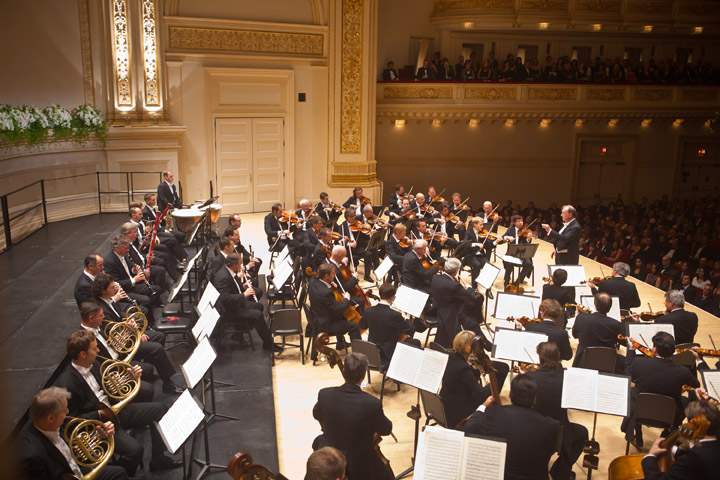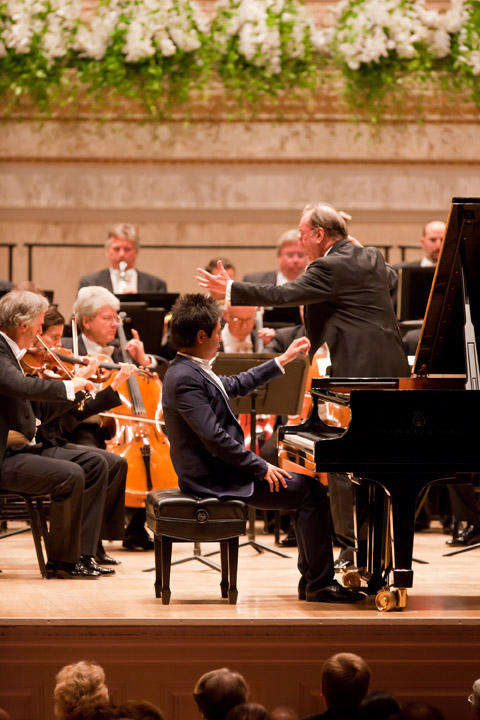If the Orchestra’s first program was distinctly conventional, the second program was distinctly unusual: Bedrich Smetana’s six-part tone poem “Ma Vlást” (My Homeland). Though rarely performed in its entirety, the second movement, “Vltava” (The Moldau), is often played separately and has become an audience favorite.
Smetana (1824-1884) has been called the founder of nationalism in music. At a time when his country was part of German-speaking Austria, he studied and mastered Czech, an extremely difficult language, joined the nationalist movement, and incorporated Czech folk-music into his compositions. (The most famous one is the delightful comic opera, “The Bartered Bride.”) “Ma Vlást,” a highly programmatic work, is a celebration of Czech culture, history, and the beauties of the countryside.
The first movement, “Vysehrad,” describes the grand medieval Castle that once towered above Prague; its theme, the majestic opening arpeggios played alternately by two harps (seated in this performance on opposite sides of the stage), recurs in different forms in several movements.
The second movement, “Vltava,” is a Rondo whose theme is a broad, haunting melody with a strange resemblance to Israel’s national anthem, “Hatikva” (Hope). The music follows the river from source to estuary; on the way, it encounters peasants frolicking at a wedding, elves dancing in the moonlight, a forest hunt, and the rapids. When it passes Prague and Vysehrad, the harps re-state their arpeggio theme, taken up emphatically by the orchestra.
The third movement, “Sarka,” is a percussion-driven war-like march. Sarka, a maiden betrayed by her lover, seeks revenge on all men; she has assembled a band of warrior-maidens to battle an army of men. She tricks its leader into falling in love with her, then drugs the men into a drunken sleep and calls on her women to slaughter them. The music is loud, wild, and chaotic – a vengeful orgy.
Peace is restored in the fourth movement, “In Bohemia’s Fields and Forests.” It, too, is sometimes heard separately; its pastoral serenity, melodic flow, rich harmonies and concluding cheerful dance have made it almost as popular as Vltava.
The last two movements, “Tabor” and “Blanik” are meant to be played together, because both are based on the same Hussite hymn. Tabor is a Bohemian town used by the followers of Jan Hus (later executed as a rebel) as the site of their resistance to royal authority. Blanik is a mountain where a band of dead knights (or their spirits) stands ready to aid the nation in times of travail. The Hussite chorale serves as a majestic march of the rebellious and ultimately victorious Hussites, and finally as an assertion of “the resurrection of the Czech nation, its future happiness and glory.” “Tabor” is perhaps a bit too long; the chorale is repeated too many times, though in different keys, but “Blanik” is concise and ends triumphantly, with the Vysehrad theme sounding in the distance.
The work was ideally suited to the famous “Vienna” sound: the warm, velvety strings, the colorful woodwinds, the mellow brass, especially the prominent horns. The musicians seemed to revel in their own ravishing tone, the masterful orchestration, the idiomatic Czech rhythms and melodic lines. Again, the only flaw was a lack of balance: the middle voices often obscured the melodies and the brass and percussion were too loud.


